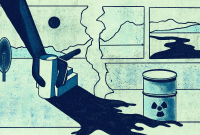Support strong Canadian climate journalism for 2025
Ontario's largest power company is exploring the possibility of importing nuclear reactors from France. This is a waste of time and money for Ontario Power Generation (OPG).
There is enough historical evidence that the reactors being sold by French utility Electricité de France (EDF) are immensely expensive, take very long to build, and are unreliable.
OPG should instead focus its efforts and investments on building an energy system based on renewable technologies. Most Canadians realize such a system would be affordable and secure.
Ontario’s nuclear reactor fleet is horrifically expensive, resulting in Ontario Hydro’s $38.1-billion debt and its restructuring. Nevertheless, during the first decade of this century, OPG started planning to build two more reactors at the Darlington site.
These plans were abandoned after sticker shock: Atomic Energy of Canada Limited’s bid was a staggering $26 billion for two 1,200-megawatt (MW) CANDU reactors, over three times the government’s proposed estimate. Accounting for inflation, that would translate to 36 billion in today’s dollars.
Around the world, 234 nuclear reactor projects have been suspended or abandoned, often after billions have been spent. Recently the V.C. Summer project in South Carolina cost over US$9 billion before the bleeding was stopped.
OPG’s latest exploration is unlikely to go well, especially because of the sorry record of Électricité de France on a range of metrics, including its new reactor projects. On its home turf, the 1,630-megawatt European Pressurized Reactor (EPR) being built in Flamanville is now projected to cost $14.4 billion, more than four times the initial estimate; additional financing costs could amount to $7.4 billion.
Across the channel, the planned cost of EDF's Hinkley Point C project in the U.K. with two EPRs has more than doubled, with the latest estimate only slightly short of $40 billion. This follows the pattern of nuclear reactors exhibiting negative learning, with costs increasing as more are built.
Nuclear power is often justified by invoking climate change. The timeline for EDF's reactors shows why this argument is not justified — the time it takes to build reactors is too long to mitigate global warming.
For example, when EDF started building the Flamanville-3 reactor in 2007, it anticipated starting operations in 2012; French citizens have yet to see the reactor produce any power.
Finland’s only EPR, the Olkiluoto-3 reactor, took nearly 20 years to go from when the Finnish parliament approved construction to being connected to the nation's grid. Finally, even in China, which is reputed to deliver projects on time, the two EPRs at Taishan took twice as long as originally anticipated.
EDF's shaky financial ground doesn't help either. In early 2023, EDF faced one of the biggest financial fallouts in French corporate history, reporting a record loss of €17.9 billion, with debt reaching €64.5 billion.
The losses were partly a result of having to shut down many reactors in its fleet due to corrosion issues. On average in 2022, each reactor in France was not producing power for 152 days of the year.
The corresponding figures for 2019, 2020 and 2021 were 96, 115, and 104 days, respectively. In other words, EDF’s reactors are unreliable.
The irony is that nuclear advocates often propagate the myth that renewables cannot be the basis of a reliable electricity grid, even in the face of such poor performance from reactors.
OPG needs to only look to history to see what could go wrong if it proceeds with importing reactors from EDF. Even a single reactor from EDF will cost tens of billions, will be delayed by up to a decade, and then might not operate reliably.
The alternative for OPG is clear — invest in wind and solar energy.
These technologies have become dramatically cheaper and are increasingly competitive, even without considering the long-term costs of radioactive waste management and decommissioning associated with nuclear power.
Moreover, solar and wind projects can be executed within a couple of years, not decades. This is critical if we are to have any chance of meeting any targets related to climate change mitigation.
Laura Tanguay is a PhD candidate in the Faculty of Environmental and Urban Change at York University researching consent mechanisms in nuclear waste siting processes in the Canadian landscape. She works to support Indigenous communities who are confronted with settler land-use and water-use propositions in regulatory, scholastic and grassroots settings, and has co-edited a report on “Operationalizing Indigenous-led Impact Assessments.”
M.V. Ramana is the Simons Chair in disarmament, global and human security and a professor in the School of Public Policy and Global Affairs at the University of British Columbia. He is the author of The Power of Promise: Examining Nuclear Energy in India (Penguin Books, 2012) and Nuclear is not the Solution: The Folly of Atomic Power in the Age of Climate Change, to be published by Verso Books this year.








Comments
How will you provide base-load?
How will something that doesn't work for 152 days of the year, or which isn't built yet because it's taking 20 years, provide base-load?
Great article with solid analysis on the folly of this proposal to look to EDF for new reactors. Thanks.
Solar, wind and batteries are 2 to 3 times cheaper than nuclear.
I am glad that these writers have made the case against the expansion of nuclear power generation so compellingly. There is a case to be made for continuing to operate existing nuclear power generation for as long as it will safely operate (notwithstanding its inherent risks and long term storage costs for spent nuclear fuel) without putting more billions into overhaul or rebuilding. We are already committed to their eventual huge decommissioning costs.
The notion that we should replace fossil fuel power generation with nuclear power generation is superficially attractive, but in fact we would merely be replacing one enduring hazard to humanity with a different and staggeringly expensive one.
"The Case Against Nuclear Power: A Primer"
https://www.counterpunch.org/2022/09/09/the-case-against-nuclear-power-…